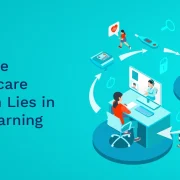
How To Create a Feedback Culture For Corporate Training
Feedback is a powerful tool that can help measure the effectiveness and ROI of your training. No matter if it’s a standing ovation or a gut punch, feedback helps us know what we’re doing right or where we’re going wrong.
A feedback culture includes a genuine feedback system between employees and managers, between managers and executives, and among employees. It gives companies more opportunities to innovate and spot issues to help employees improve and grow together.
It’s no wonder that 89% of HR leaders believe regular check-ins and peer feedback improves their organizational culture. Having a strong feedback culture in place can make you a talent investor. It can take your workplace training projects to a new level.
Constructive feedback creates an open learning environment that can boost learner engagement, reduce employee turnover, and also cut down training costs through effective mentorship.
But designing a feedback culture is easier said than done. Here are some steps that can help you create an open feedback culture for a safe and positive learning environment at your workplace.
1. Begin from the Top
To create a sustainable change in your workplace, getting the leadership on board is paramount.
When leaders seek feedback from co-workers and managers, they set an example for other employees. It also makes the management personally accountable for their actions or any mistakes.
When employees observe that their managers follow strong feedback principles, they are more likely to be inspired to adapt.
On the contrary, if the leaders fail to hone their skills to request or share feedback, the employees will also not take the feedback system seriously.
2. Promote a Growth Mindset
Employees with a growth mindset are always willing to improve their skills through hard work and learning. They consider feedback as an opportunity to grow. This makes them an asset for any company having an effective feedback culture.
But how do you integrate it into your business? The key is to nurture a growth mindset in your workplace. This can be achieved in the following ways:
- Consider a candidate’s attitude towards growth and failure at the time of hiring.
- Provide tuition reimbursement, invest in employees’ professional development, offer learning opportunities, and cover certificate or professional license costs.
- Reward employees for making an effort towards self-development.
3. Provide Feedback Training
Sharing and requesting feedback requires certain skills that can be acquired through feedback training. It takes time and consistent efforts to develop a strong feedback culture.
Empowering your employees with the right resources and conducting regular feedback training sessions can help them adapt to the new feedback culture more effectively.
The following are some tips to ensure that all your employees are on the same page when it comes to feedback training:
- Organize annual workshops on how to give and receive feedback.
- Share articles or videos to illustrate excellent and poor feedback interactions.
- Encourage employees to raise their concerns and train them on seeking examples, asking questions, and requesting clarifications.
- Develop managerial skills in designing realistic learning goals and assisting employees in achieving them.
4. Equip the Team with Feedback Tools
Leverage technology to take the burden of administrative work off your team’s shoulders, enabling them to focus on growth.
Advanced feedback tools allow employees to have two-way conversations, make notes from feedback training sessions, give encouraging feedback through recognition, request 360 feedback, and gather feedback via surveys.
This documents feedback in one place, enabling managers to view past feedback. This not only helps in motivating the direct reports but also in streamlining performance reviews and feedback conversations among employees. A feedback tool is worth the investment.
5. Build a Feedback Structure with Clear Expectations
Develop feedback standards to help employees and managers know what to expect from the feedback system. In other words, your stakeholders and learners must be aware of how to give and receive feedback.
To set clear expectations, ask yourself the following questions:
- Who receives or gives feedback? – It will set expectations for managers, learners, executives, and the HR/L&D department.
- What does the feedback aim to achieve? – Will it enhance your training design, content, or delivery? This will determine how the feedback will impact the entire learning program.
- How often will it occur? – Decide if it will happen monthly or quarterly based on your company’s needs.
- How will it take place? – Choose between verbal and written communication and decide on the set-up.
E-Book:
Hurix Mini-Book: Effective Training Techniques For Enterprises With Distributed Workforce
6. Use Diverse Feedback Channels
Including a variety of feedback channels can make your feedback system more accessible and effective for all. After all, different scenarios demand different feedback channels. What’s more, people from different backgrounds and teams bring fresh perspectives.
Depending on the goal of the feedback, you can try the following:
- Anonymous feedback – Present the feedback without the giver’s name so that people can be honest without worrying about suffering reprisals.
- 180 and 360-degree feedback – Including feedback from different teams to offer a rounded picture of the learner’s performance.
- Face-to-face feedback – Consulting learners to help them verbalize their opinions.
- Feedback through group discussions – Having quick group discussions so that learners can share their ideas with co-workers.
7. Make It a Habit
Quarterly or annual feedback has now become a thing of the past. Today teams are embracing continuous feedback to learn and improve consistently.
Conducting more informal meetings or having regular feedback conversations allows your learners to discuss what they’re struggling with. They can also pinpoint areas of improvement for the training programs.
What’s more, practicing continuous feedback can reinforce the feedback culture in your company. It will soon turn into a habit, integrating with your learners’ routine.
8. Nurture a Healthy and Safe Environment for Feedback
Imagine how great it would be if everyone were comfortable sharing and requesting feedback. Wouldn’t it be amazing if your learners perceived feedback as a present rather than feeling hammered?
For this to happen, it’s essential to nurture a feedback-safe environment where employees trust each other and receive feedback positively. The comfort levels vary from employee to employee.
Care should be taken to respect their feelings and not force feedback. Here’s where emotional intelligence can help in gauging if a person is willing to receive or give feedback.
Wrapping Up
To sum it up, we would say that different feedback from different teams and personnel can go a long way in optimizing your learning programs. Many businesses have already implemented more regular check-ins to focus on employee well-being.
For more tips and insight on how to instill a healthy feedback culture in your company, get in touch with Hurix Digital today. Our team of experienced professionals can also help you create an effective learning environment to boost your employees’ productivity.

Senior Vice President
Julia brings over 20 years of global experience in digital learning and business strategy. She specializes in client success, enterprise learning solutions, and driving growth through innovation, with a focus on AI, VR, and emerging technologies across diverse industry verticals.




